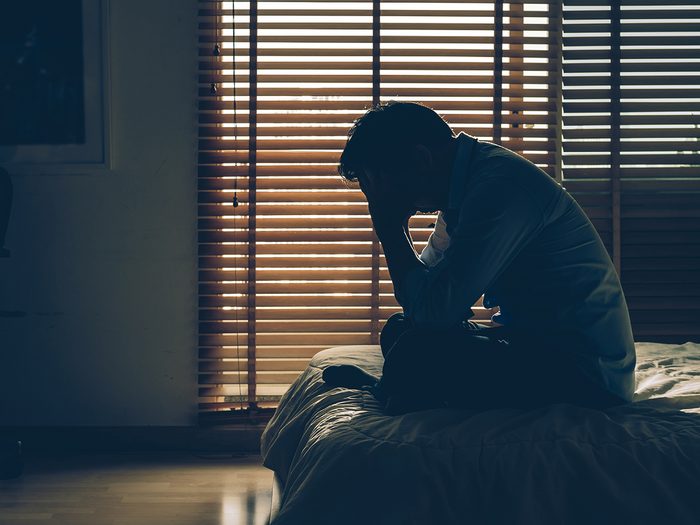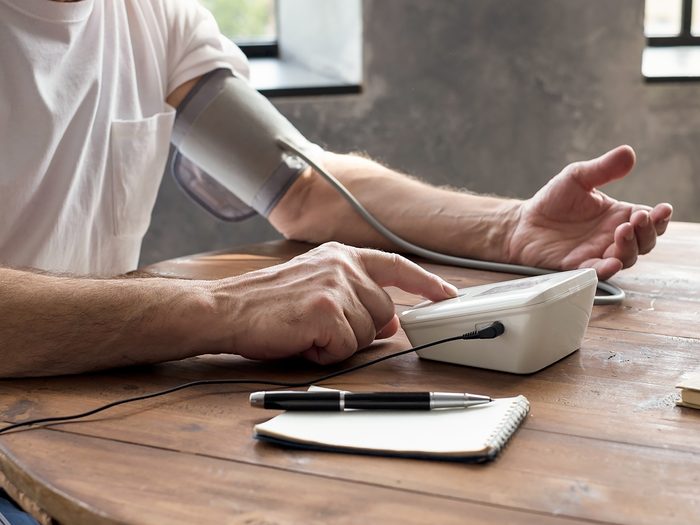
Symptoms of Generalized Anxiety Disorder
Jim Folk’s anxiety odyssey began in 1974 with an upset stomach. Next came muscle tension, dizziness and heart palpitations. At the time, Folk was 21 years old and working in his family’s auto-repair shop in Regina. When his symptoms didn’t go away, he grew worried. “Whenever I had an ache or pain, I’d freak out,” says Folk, now in his 60s.
After a few months, he saw his doctor, who told him it was just stress and to go home and rest. “But I didn’t feel stressed,” Folk says. “And I couldn’t figure out why every time I tried to relax, my symptoms went full tilt.”
At first, Folk was convinced he had multiple sclerosis, or maybe cancer, even when doctors reassured him that he didn’t. He began experiencing non-stop nausea coupled with debilitating panic attacks. “I’d start trembling all over, feel dizzy and have hot flashes,” he says. “I was in the bathroom countless times, heaving with intense stomach upset. My symptoms were robbing me of more and more of my life.”
Years passed, but his health failed to improve. Folk saw several doctors and mental health professionals and tried an array of pills and herbal remedies. Nothing worked. “My whole life revolved around a few blocks—to work and back home again. I could barely drive, couldn’t visit friends, couldn’t enjoy my family.”
Eventually his wife at the time told him he needed to get better or their marriage was over. Folk booked an appointment with a psychologist. Two weeks later—and 10 years after the onset of his symptoms—he was finally diagnosed with generalized anxiety disorder and panic disorder.

What a Generalized Anxiety Disorder Diagnosis Entails
Generalized anxiety disorder, or GAD, is a condition characterized by persistent, excessive worry—even when there’s nothing concrete to worry about. “People with GAD try to plan for every eventuality, all the time,” says Dr. Melisa Robichaud, a psychologist in Vancouver. “It’s cognitively exhausting.” It can be physically taxing, too, with symptoms ranging from fatigue and irritability to difficulty maintaining concentration to restlessness or agitation.”
At its core, Robichaud says, anxiety is the body’s most basic survival mechanism, the fight-or-flight response you get when you feel threatened. “Anxiety is like the body’s smoke alarm: whether there’s smoke or fire, it makes the same noise.” It can be triggered by real danger but also by anything we perceive as dangerous.
People with GAD think through “what-if” scenarios excessively, and this cycle of worries can end up provoking even more anxiety. The thought of an unpaid bill can quickly escalate to worrying about what they’ll do if they wind up homeless. “They’re constantly in their heads and they can’t stop their worrying once it begins,” Robichaud says.
Here are 10 signs you could use the help of a therapist.

Generalized Anxiety Disorder is Common in Older Adults
While scientists aren’t entirely sure why some people are more prone to generalized anxiety disorder than others, part of the risk is genetic, says Simon Sherry, an associate professor of psychology and neuroscience at Dalhousie University in Halifax. The condition also often coincides with other illnesses, such as depression, and women are twice as likely as men to be affected, according to Sherry.
As anxiety disorders go, GAD is one of the most common, especially in older adults. Studies suggest it affects somewhere between three and 10 per cent of people, says Julie Wetherell, a psychologist at VA San Diego Healthcare System and professor of psychiatry at the University of California, San Diego who focuses much of her research on psychological treatments for GAD in elderly patients. “GAD is more common in seniors than social-anxiety disorder, panic disorder, post-traumatic stress disorder and major depression.”
It also manifests a little differently in people who are 55 and older. Wetherell says they tend to worry less about work and more about personal health and family issues. “Sometimes people have a lifelong history of anxiety that they’ve coped with through distraction or workaholism,” she says. “The pervasiveness of the worry becomes apparent when they’re no longer working or once they’re unable to engage in previous coping strategies.”

Challenges in Getting Diagnosed
Anxiety symptoms are associated with several health issues, which can make diagnosis difficult. Conditions that can cause—or mimic—anxiety include coronary artery disease, chronic obstructive pulmonary disease, dehydration and hyperthyroidism. “It’s possible to have both a medical condition and anxiety, so when a medical condition is diagnosed, anxiety may remain untreated,” Wetherell says. Anxiety-like symptoms can be caused by medications, including blood pressure pills, hormones, steroids, antidepressants and over-the-counter drugs that contain caffeine, like some cough syrups and decongestants.
GAD sufferers rarely turn to psychologists and will instead often see a medical doctor about their physical symptoms. In some cases, professionals brush off both physical and psychological concerns. “Many people think that worry isn’t a legitimate mental health complaint since everybody frets,” Robichaud says. She’s seen patients who endured symptoms for 15 years before seeking help. Older adults tend to downplay problems with anxiety. GAD sufferers often get accustomed to their extreme patterns of thinking, Sherry says. “If worry is your normal, you may not appreciate the extent to which you’re living in distress,” he says. “But while GAD is common, costly and impairing, it’s also highly treatable, which is why it’s important to seek help.”
Here are 20 symptoms you should never ignore.

Mindfulness-Based Treatments
It took two years of treatment before Folk was symptom-free. “While I had reasonable moments during the 12 years I was ill, most of the time was horrible,” he says. “My anxiety disorder felt like a nightmare I couldn’t wake up from.”
Folk’s psychologist taught him that he could react physically, even when he wasn’t aware that he was anxious, and explained why he wasn’t able to calm himself down. “It was helpful for me to know what was going on in my body,” Folk says. “Then it took a year of stress reduction and daily self-reflection strategies to help me learn not to react to life with fear.”
His success in overcoming GAD eventually led him to found anxietycentre.com, a site that offers information and counselling by mental health professionals to those grappling with the condition. The guidance provided on the site is based on cognitive behavioural therapy, which is the gold standard in treating anxiety disorders. CBT teaches patients to change their unhealthy patterns of thinking and behaviour in order to help them function normally. “I worked hard at overcoming my fear of anxiety and panic attacks and, over time, my symptoms subsided,” Folk says. He’s been symptom-free since 1985.
While some medications can help treat anxiety, they come with serious side effects, such as sedation, cognitive impairment (over long-term use) and even the development of a tolerance, which can lead to addiction. Wetherell often recommends a non-pharmaceutical approach rooted in relaxation and meditation.
“Our research team is currently using Mindfulness-Based Stress Reduction, which has no side effects,” she says. (MBSR techniques include mindful breathing and mental body scans to increase awareness of physical sensations.) “We found that MBSR reduces cortisol, a stress hormone that damages the hippocampus and frontal lobe of the brain, so it may have beneficial effects on memory and thinking, as well as on anxiety.”
Wetherell says there are videos on YouTube that lead people through body scans (which coach participants in bringing awareness to each part of the body sequentially) and other mindfulness techniques. “I encourage people to practise daily so they can use relaxation techniques when they’re anxious,” she says.
Other studies support Wetherell’s findings. In 2022, researchers from the Georgetown University Medical Center in Washington, D.C., found a mindfulness-based stress reduction program as effective as anti-depressant drugs in treating anxiety disorders. An important aspect of mindfulness is to learn to zero in on present-moment experience, says Robichaud. “For GAD patients, worries involve thoughts about negative events that might occur in the future, so being able to focus on the present can be beneficial.”
To remain present, Christine Purdon, professor in the department of psychology at the University of Waterloo, suggests patients be aware of the tenses they’re thinking in. “I ask them, ‘Is your mind in the future? Does it need to be there?’” Purdon shows people how to recognize that whatever they’re worrying about is neither imminent nor realistic. The goal, she says, is also to help people realize when they’re underestimating their ability to cope and overestimating the demands of their environment.
Discover more benefits of daily meditation.

Lifestyle Changes May Help
For mild cases of GAD, one of the most important changes is exercise. Researchers at Princeton University found that physical activity reorganizes the brain in a way that reduces the organ’s response to stress so that anxiety is less likely to interfere with normal brain function. Exercise can also tire you out, so you sleep better—and sleep is key. Lack of shut-eye can contribute to excessive worrying.
So can too much time spent on social media. In 2017, a study published online by the journal Computers in Human Behavior showed that using multiple social media platforms increases the risk of anxiety and depression (multi-tasking and switching from one thing to another are associated with poorer attention, cognition and mood).
There’s also some evidence that what you eat may play a role in your ability to calm your mind. A 2015 study in the journal Psychiatry Research found that eating foods high in probiotics (pickles, kefir, sauerkraut) may protect against symptoms of social anxiety. And a 2011 U.S. study found that fare high in omega-3s (such as fatty fish) has been linked to lower anxiety.
Find out more foods that can boost your mood.

Being Patient with Yourself is Key
Although you can reduce—or even overcome—GAD, maintaining solid mental health remains a lifelong process. Mark Virgin, a 54-year-old lawyer in Vancouver, was diagnosed two years ago and sees his psychologist twice a year for checkups. “I still suffer from anxiety, but now I’m equipped with coping mechanisms,” he says. Virgin tries to meditate daily. He’s also reduced his coffee and alcohol consumption and stays committed to an exercise regimen. (Here’s what can happen when you start walking 10,000 steps a day.)
Afraid of how the stigma associated with mental illness might affect his work and relationships, Virgin initially attempted to mask his symptoms, until they became crippling. He would worry about potential issues—usually work related—and build up improbable, worst-case scenarios in his head. “It got to the point where I was having a hard time leaving my home—and I’m a pretty extroverted person,” he says.
CBT helped Virgin recognize the implausibility of the catastrophic narratives he had been constructing. One of the strategies he found to be most useful was writing out the scenarios, then reading them back. “I was suddenly struck by how disproportionate what I’d constructed was to reality,” he says.
Virgin now speaks openly with co-workers and friends about his experience, with the goal of encouraging others to address their symptoms. “I decided to share to try and de-stigmatize it,” he says. He hopes that dialogue will allow others to speak freely and learn about treatment options. “It’s exceptionally liberating when you finally have the tools to manage this disorder.”
Next, check out 10 mental health podcasts worth adding to your playlist.